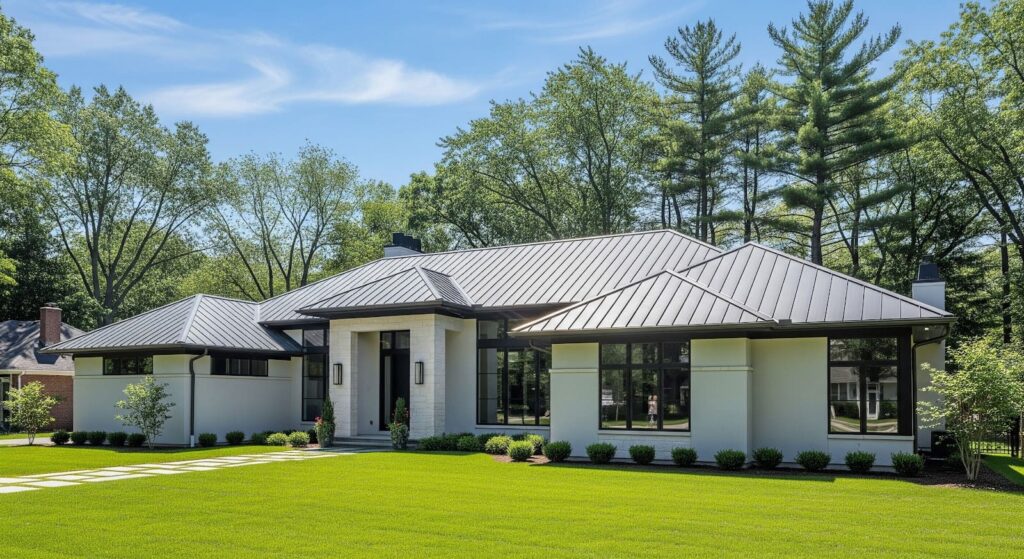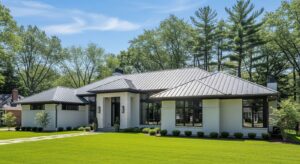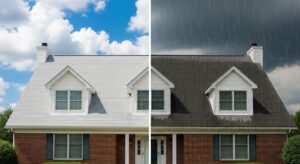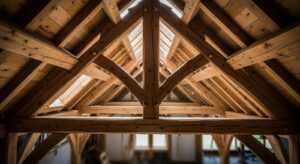Metal roofing has become increasingly popular among homeowners across the United States, and for good reason. These durable systems can last 40-70 years with proper care, making them an excellent long-term investment for your home.
However, like any roofing material, metal roofs require regular attention to maintain their performance and appearance. Without proper metal roof maintenance, even the highest-quality installation can develop problems that lead to costly repairs or premature replacement.
This comprehensive guide will walk you through everything you need to know about keeping your metal roof in top condition, from seasonal care tasks to recognizing when professional help is needed.
Why Metal Roof Care Matters
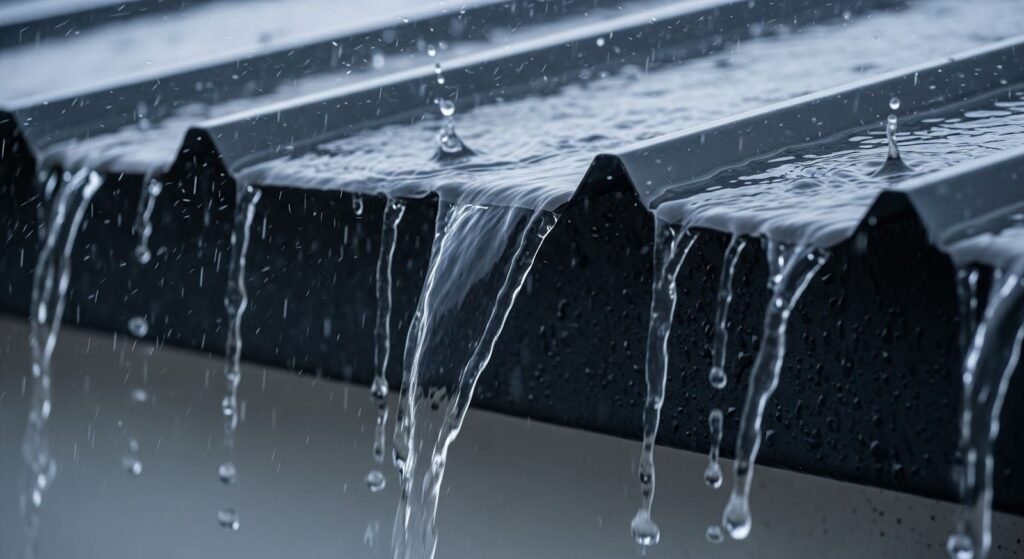
Metal roofing systems are built to withstand harsh weather conditions, but they’re not maintenance-free. Regular steel roof maintenance helps prevent small issues from becoming major problems.
A well-maintained metal roof protects your home’s interior from water damage, maintains energy efficiency, and preserves your property’s curb appeal. Neglecting routine care can lead to rust, loose fasteners, and compromised weatherproofing.
In states like Texas and Florida, where intense sun and severe weather are common, proper metal roofing upkeep becomes even more critical. The investment in regular maintenance pays dividends by extending your roof’s lifespan and preventing emergency repairs.
Annual Metal Roof Maintenance Checklist
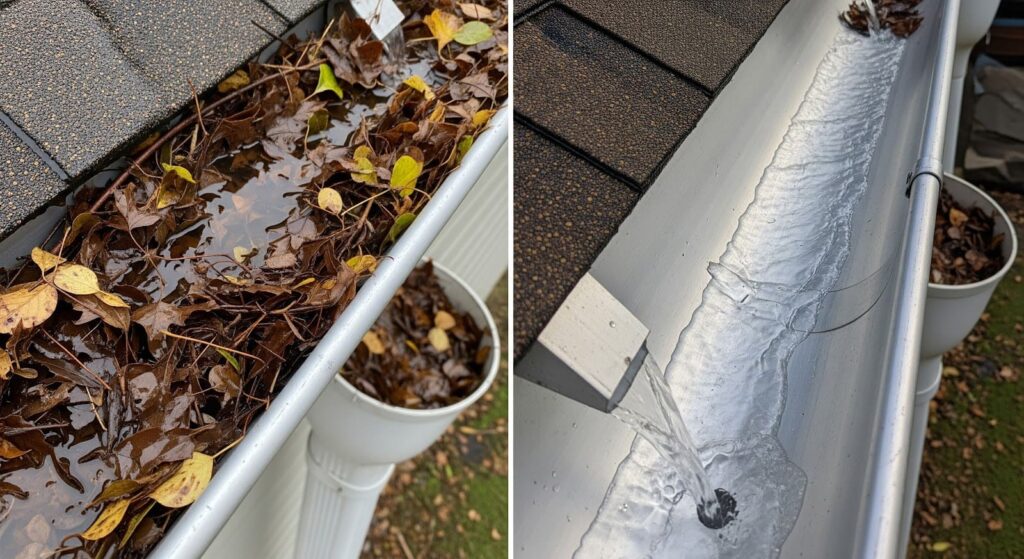
Creating a yearly maintenance routine helps ensure nothing gets overlooked. Here’s your essential annual checklist for comprehensive metal roof care:
Visual Inspection Tasks
Start each year with a thorough visual inspection of your entire roofing system. Look for any obvious signs of damage, wear, or deterioration that developed over the previous year.
Walk around your property and examine the roof from ground level using binoculars. Check for these common issues:
• Loose or missing panels that may have shifted during storms • Rust spots or discoloration indicating potential corrosion • Damaged or missing fasteners that compromise panel security • Bent or warped sections from impact damage • Gaps in seams or joints that could allow water infiltration
Gutter and Drainage System Check
Your gutters and downspouts work hand-in-hand with your metal roof to protect your home. Clogged or damaged gutters can cause water to back up under roofing materials.
Clean all gutters and downspouts thoroughly, removing leaves, debris, and any rust or corrosion. Ensure water flows freely through the entire drainage system.
Replace any damaged gutter sections and tighten loose brackets. Consider installing gutter guards to reduce future maintenance needs, especially if your home is surrounded by trees.
Source: For comprehensive roofing maintenance guidelines, reference the National Roofing Contractors Association (NRCA) Manual, which provides industry-standard practices for metal roof systems.
Sealant and Caulk Inspection
Weather can cause sealants around roof penetrations to crack or shrink over time. Inspect these critical areas:
• Vent pipe boots and collars for proper sealing • Chimney flashing connections and mortar joints • Skylight perimeters and mounting hardware • HVAC equipment mounting points and ductwork • Antenna or satellite dish attachment points
Remove old, cracked sealant and apply fresh, high-quality roofing sealant as needed. This simple step prevents water infiltration that could cause significant interior damage.
Seasonal Metal Roof Care Tasks
Different seasons bring unique challenges for metal roofing systems. Adapting your maintenance routine to seasonal conditions helps address problems before they escalate.
Spring Maintenance Priorities
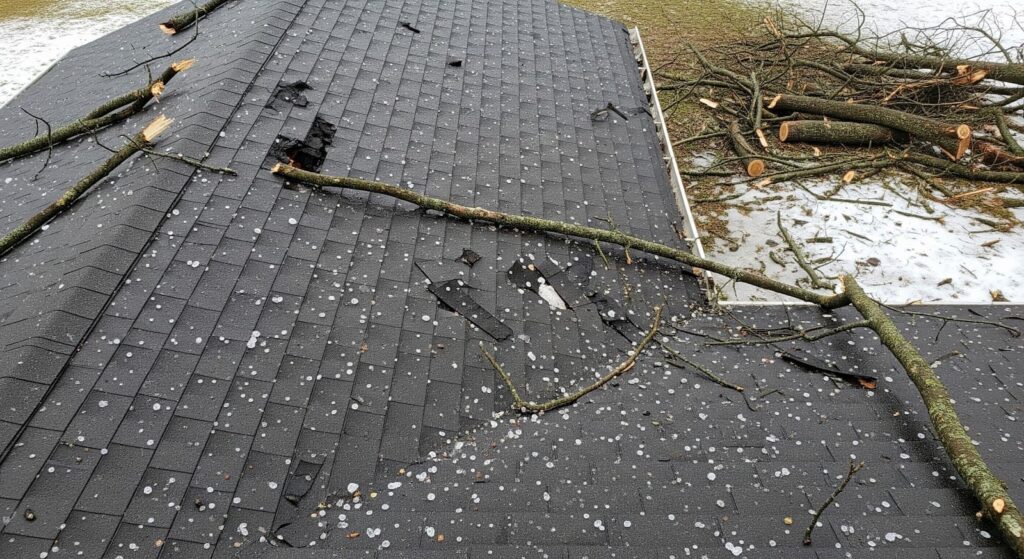
After winter weather passes, spring is the perfect time for a comprehensive roof assessment. Winter storms, ice, and temperature fluctuations can create new issues that need attention.
Check for any panels that may have shifted during winter storms. Look for new dents from hail or impacts from falling branches.
Inspect and clean all roof-mounted equipment like satellite dishes, solar panels, or HVAC units. Ensure mounting hardware remains secure and hasn’t created new penetration points.
Summer Care Considerations
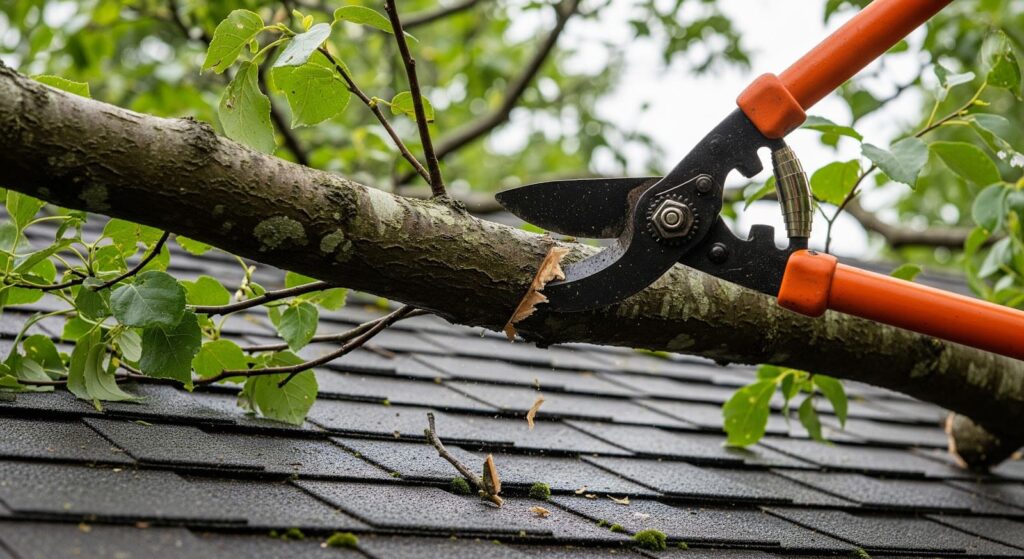
Hot summer temperatures can cause metal roofing materials to expand, potentially affecting fastener tightness and panel alignment. Schedule maintenance tasks for cooler morning or evening hours to avoid working on extremely hot surfaces.
Focus on ventilation system cleaning during summer months. Proper airflow helps reduce cooling costs and prevents moisture buildup in attic spaces.
Trim any tree branches that hang over your roof. Falling leaves and branches can cause damage, and overhanging vegetation creates shaded areas where moisture accumulates.
Fall Preparation Tasks
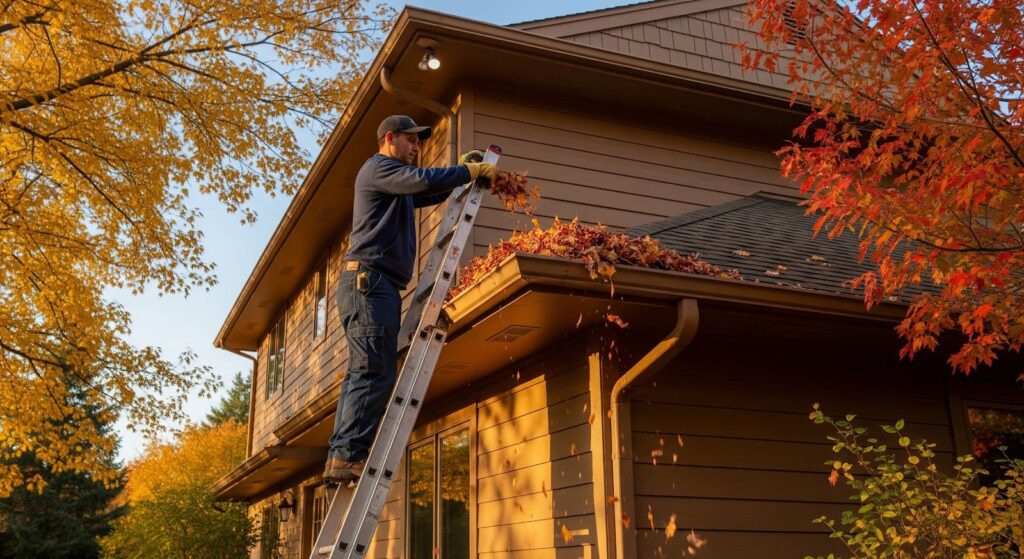
Fall maintenance prepares your metal roof for winter weather challenges. Start by thoroughly cleaning all gutters and downspouts before leaves begin falling in earnest.
Inspect and tighten all fasteners, as thermal expansion and contraction throughout the year can cause them to loosen. Pay special attention to ridge caps and end panels, which experience more wind stress.
Check snow retention systems if your area receives significant snowfall. Ensure snow guards or snow fences are securely attached and properly positioned.
Winter Monitoring
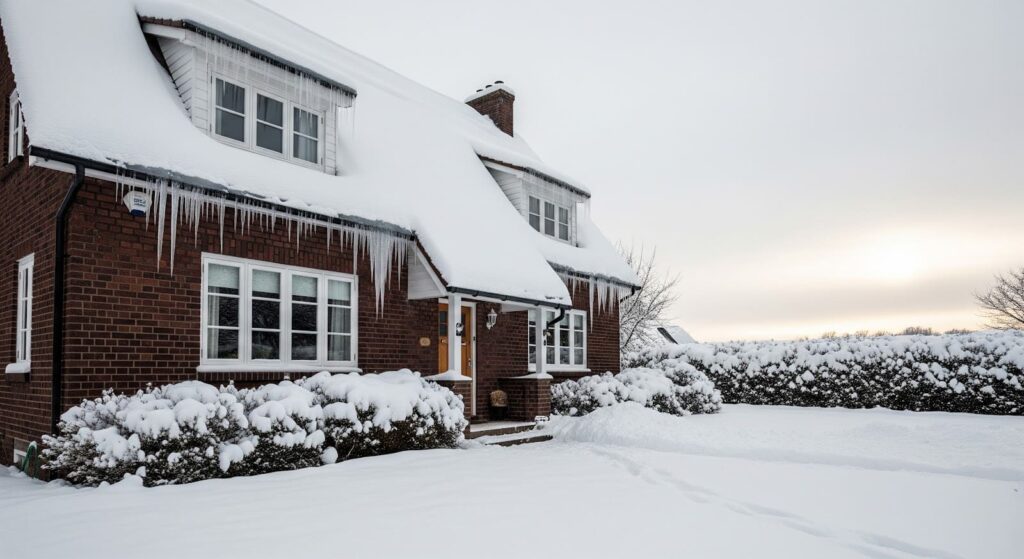
While you shouldn’t climb on icy or snow-covered metal roofing, winter monitoring from the ground helps identify potential problems early.
Watch for ice dams forming along roof edges, which can indicate ventilation or insulation issues. Remove snow buildup if it exceeds manufacturer recommendations for your roofing system.
Monitor for icicles forming in unusual locations, which may signal water infiltration or inadequate drainage.
Signs Your Metal Roof Needs Professional Attention
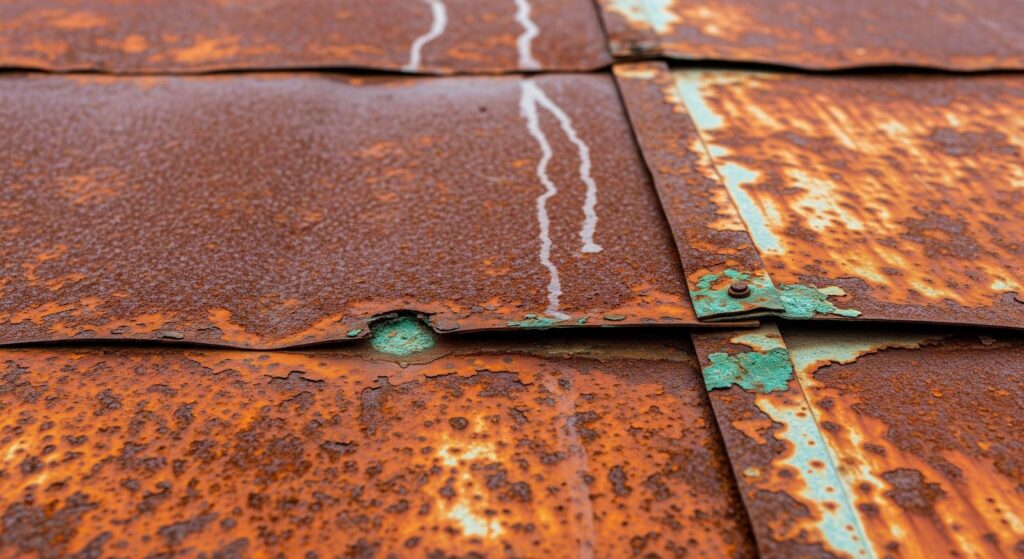
While homeowners can handle many maintenance tasks, certain situations require professional expertise. Recognizing these warning signs helps you address problems before they cause extensive damage.
Water Leaks and Staining
Any evidence of water infiltration demands immediate professional attention. Interior stains, dripping, or moisture in attic spaces indicates compromised weatherproofing.
Even small leaks can cause significant damage to insulation, structural components, and interior finishes. Professional roofers have the tools and expertise to locate leak sources and implement lasting repairs.
Don’t attempt to patch leaks yourself with temporary solutions. Improper repairs often make problems worse and can void manufacturer warranties.
Structural Issues
If you notice sagging sections, loose panels, or damaged support structures, contact a professional immediately. These issues can compromise your roof’s ability to protect your home and may pose safety risks.
Metal roofing systems rely on proper structural support and secure fastening. DIY repairs to structural components rarely provide adequate long-term solutions.
Professional assessment helps determine whether repairs are sufficient or if partial replacement is necessary to ensure continued performance.
Extensive Rust or Corrosion
While minor surface rust can often be addressed with DIY treatments, extensive corrosion requires professional evaluation and treatment. Rust that has penetrated through protective coatings needs specialized repair techniques.
Professional roofers can assess whether rust damage is localized or indicates broader system problems. They have access to commercial-grade rust treatment products and protective coatings.
In coastal areas where salt air accelerates corrosion, professional treatment may be necessary every few years to maintain warranty coverage.
DIY vs Professional Metal Roof Maintenance
Understanding which tasks you can safely handle yourself and which require professional expertise helps you maintain your roof cost-effectively while ensuring safety and quality.
Safe DIY Maintenance Tasks
Many routine maintenance activities are well within most homeowners’ capabilities. These tasks require basic tools and common sense safety precautions.
Gutter cleaning and minor debris removal from roof surfaces are straightforward DIY projects. Use proper ladder safety techniques and avoid walking directly on metal panels when possible.
Visual inspections from the ground using binoculars allow you to assess roof condition without climbing. Document any concerns with photos for professional consultation.
Applying caulk or sealant around small penetrations is another manageable DIY task. Use high-quality products designed specifically for metal roofing applications.
When to Call Professionals
Complex repairs, structural issues, and warranty-related work should always be handled by qualified professionals. Attempting these repairs yourself can create liability issues and void manufacturer warranties.
Any work involving electrical components, HVAC equipment, or solar panel systems requires professional expertise. These systems have specific safety requirements and integration considerations.
If your roof is more than two stories high or has steep slopes, professional service is safer and more practical. Roofers have specialized equipment and training for working at height.
Finding Qualified Contractors
When selecting a metal roofing professional, verify licensing, insurance, and manufacturer certifications. Many metal roofing manufacturers require specific training for warranty-covered work.
Request references from recent customers and check online reviews from multiple sources. A reputable contractor should be happy to provide proof of insurance and bonding.
Get detailed written estimates that specify materials, labor, and timeline. Be wary of door-to-door contractors or those who demand full payment upfront.
Cost of Metal Roof Maintenance Services
Understanding typical maintenance costs helps you budget appropriately and make informed decisions about DIY versus professional services.
Annual Maintenance Costs
Professional annual inspections typically cost between $200-500, depending on roof size and complexity. This investment often prevents much more expensive emergency repairs.
Basic gutter cleaning services range from $150-400 for most residential properties. Properties with multiple stories or complex rooflines may cost more.
Minor repairs like replacing a few fasteners or applying sealant around penetrations usually cost $200-600, depending on accessibility and materials required.
Major Repair Expenses
Replacing damaged panels or sections typically costs $8-12 per square foot, including labor. The total cost depends on the extent of damage and material matching requirements.
Flashing repairs or replacement can range from $300-1,200, depending on the location and complexity of the flashing system.
Complete roof coating or restoration services for older metal roofs may cost $3-7 per square foot but can extend roof life by 10-20 years.
Factors Affecting Costs
Roof accessibility significantly impacts service costs. Single-story homes with easy access cost less to service than multi-story properties or those with complex layouts.
Geographic location affects both labor rates and material costs. Urban areas typically have higher service costs but more contractor options.
Seasonal timing can influence pricing. Spring and fall are peak seasons for roofing work, potentially increasing costs compared to winter scheduling.
Common Metal Roof Problems and Solutions
Understanding typical issues that affect metal roofing helps you recognize problems early and take appropriate action.
Fastener Problems
Loose or backing-out fasteners are among the most common metal roof issues. Temperature changes cause metal to expand and contract, which can affect fastener tightness over time.
Check fasteners annually and tighten as needed using proper torque specifications. Over-tightening can damage panels or strip fastener holes.
Replace any fasteners showing signs of corrosion or damage. Use fasteners specifically designed for your roofing material and local climate conditions.
Panel Movement and Thermal Expansion
Metal roofing systems are designed to accommodate thermal movement, but problems can occur if expansion joints become blocked or damaged.
Keep expansion joints clear of debris and sealant buildup. These joints must remain flexible to allow normal thermal movement.
If panels appear buckled or distorted, professional evaluation is necessary. Improper installation or inadequate expansion allowances may require corrective work.
Coating and Paint Issues
Factory finishes on metal roofing can fade or chalk over time, especially in areas with intense sun exposure. While this is primarily cosmetic, severe coating degradation can affect corrosion resistance.
Consider professional recoating services if the original finish shows significant deterioration. Modern coating systems can restore appearance and extend roof life.
Touch-up painting for minor scratches or worn areas helps prevent rust initiation. Use paints specifically formulated for metal roofing applications.
Extending Your Metal Roof’s Lifespan
With proper care, metal roofing systems can provide decades of reliable service. Several strategies help ensure you get maximum life from your investment.
Preventive Maintenance Approach
Regular, proactive maintenance is far more cost-effective than reactive repairs. Develop a consistent maintenance schedule and stick to it regardless of apparent roof condition.
Document all maintenance activities and repairs with photos and written records. This documentation helps track system condition over time and can be valuable for warranty claims.
Address minor issues promptly before they develop into major problems. Small investments in preventive care prevent much larger expenses down the road.
Environmental Considerations
Your local climate significantly impacts maintenance requirements. Coastal properties need more frequent corrosion monitoring, while areas with heavy snowfall require attention to snow load management.
Trees near your home affect maintenance needs through falling debris and shade patterns that promote moisture retention. Consider selective tree trimming or removal if branches regularly impact your roof.
Air quality factors like industrial pollution or salt spray require more aggressive protective measures and more frequent professional cleaning.
Professional Maintenance Programs
Many roofing contractors offer annual maintenance programs that include regular inspections, minor repairs, and priority scheduling for emergency service.
These programs often provide cost savings compared to individual service calls and help ensure nothing gets overlooked in your maintenance routine.
Maintenance program documentation can be valuable for insurance claims and may help maintain manufacturer warranty coverage.
Frequently Asked Questions
How often should I inspect my metal roof?
Inspect your roof from the ground twice yearly (spring and fall) and schedule professional inspections annually for roofs over 10 years old.
Can I walk on my metal roof safely?
While possible, avoid walking directly on panels. If necessary, walk near structural supports and wear soft-soled shoes. Professional access is safer.
What’s the best way to clean my metal roof?
Use soft-bristled brushes with mild detergent and low-pressure water. Avoid pressure washing which can damage coatings and force water under panels.
How do I know if my metal roof warranty is still valid?
Check original warranty documentation for maintenance requirements. Keep detailed records of all maintenance and professional services as proof.
Should I remove snow from my metal roof?
Most metal roofs handle typical snow loads. Remove snow professionally if accumulation exceeds 2-3 feet or structural stress signs appear.
When should I consider replacing my metal roof?
Consider replacement after 40-70 years with proper maintenance, or sooner if experiencing frequent leaks, extensive corrosion, or structural issues.
Conclusion
Proper metal roof maintenance protects one of your home’s most important systems while preserving your investment for decades to come. The strategies outlined in this guide provide a roadmap for keeping your metal roofing in excellent condition throughout its service life.
Remember that consistent, proactive maintenance is far more cost-effective than waiting for problems to develop. By following seasonal care routines, conducting regular inspections, and addressing issues promptly, you’ll avoid costly emergency repairs and extend your roof’s lifespan.
While many maintenance tasks are within reach of motivated homeowners, don’t hesitate to call professionals for complex repairs or when safety concerns arise. The combination of diligent DIY care and professional expertise when needed ensures your metal roof will provide reliable protection for many years.
Whether you’re in the sunny Southwest or the snowy Northeast, adapting these maintenance principles to your local climate conditions helps ensure optimal performance from your metal roofing investment. Start implementing these practices today, and your roof will reward you with decades of dependable service.

